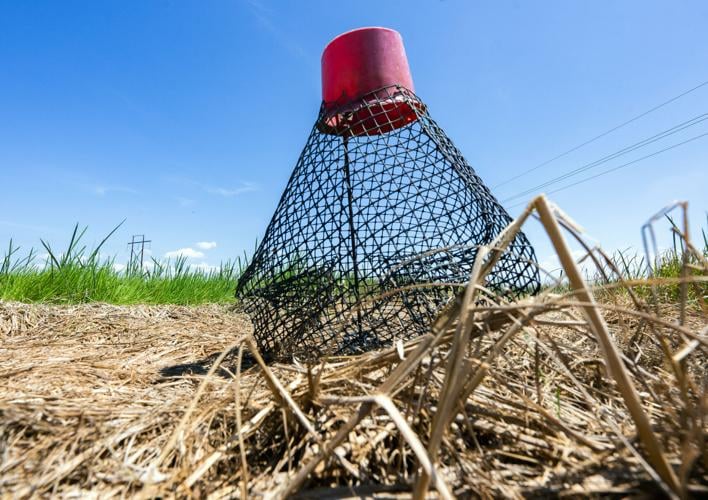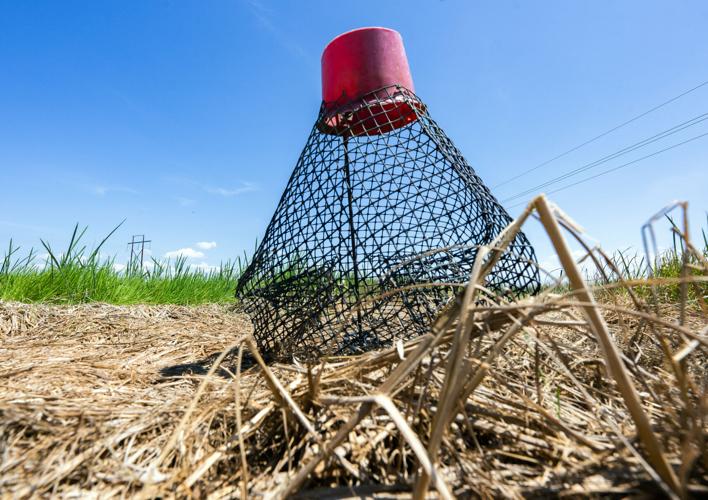Most people aren't thinking about crawfish season yet, but the cycle of producing crawfish for those springtime boils is already underway.
Mike Frugé, co-owner of Frugé Aquafarms in Acadia Parish has been preparing his fields for the early crawfish season. He introduced the seed crawfish in May to the rice crop he planted in March or April.
Crawfish mate in the open waters of rice fields in late spring, then they burrow down beneath the rice for protection from the summer heat.
This year, at least half of Louisiana has been in extreme drought, and southwestern Louisiana is the driest part of the state. The continuous streak of record-high temperatures and minimal rainfall has resulted in an impenetrable layer of clay and cracking burrows, robbing the crustaceans of the moisture nutrients they rely on during their dormancy and ultimately killing them.
“Not all of them die but enough of them die to where that first hatching doesn’t happen. Nobody knows, the signs are not good,” Frugé said.
He is hoping the extensive water pumping his farm has done over the summer for his rice crops will be enough to keep the subterranean crawfish burrows moist. It is too early to tell the extent of the damage the drought has caused, Frugé said. But he knows it will have a negative impact on the season.
The last extensive drought the crawfish industry faced was in the late 1990s and early 2000s, Frugé said. The drought lasted years rather than a summer and nearly destroyed the crawfish industry in South Louisiana, he said.
Broodstock crawfish, crawfish with eggs, rely on burrows to escape the intense Louisiana heat, Mark Shirley, an LSUAg Center crawfish specialist, said. Crawfish travel two to three feet below the surface to make their clay nest where they lay dormant for up to three months.
The soil is consistently wet during the rice growing season until July when rice fields are drained for harvest. Crawfish must rely on the remaining moisture in the soil and rainfall to keep their burrows wet for the six-week harvest period. Typically, in humid subtropical Louisiana, dried-out soil is not a concern. Shirley said that drought usually means lower production for crawfish.
“Farmers will start flooding up their fields for crawfish later in September throughout October and we're going to know a lot more within the next month or two on how detrimental of a role the drought played. There are a lot of unanswered questions now,” Jeremy Hebert an LSUAg Center Acadia field agent said.
The best way to stop soil cracking is to keep the field flushed and maintain a low three-inch flood, Shirley said. Farmers maintain a flood just below or at the burrow line. If they go over that line, it signals to the crawfish that it’s time to leave and begin foraging but daily temperatures are still too high for them to survive. Farmers are still recording daytime surface water temperatures of 90 to 100 degrees and nighttime temperatures in the 70 degrees range, Frugé said.
Farmers prefer to see nighttime water temperatures in the 60-degree range and 80-degree range during the day before flooding their crops, which typically falls around late September and early October, Shirley said.
If temperatures continue to stay elevated, Frugé said he will have to wait to flood his crops. If he did choose to flood his crops the high temperatures encourage the rice stubble and grasses to decompose rapidly and pump out carbon dioxide, robbing the water of oxygen.
“That water would turn black like dark coffee. That’s all the grass rotting out there and you can’t recover from there,” Frugé said, “Forget the drought, you just killed all the crawfish.”
To pump or not to pump
Dane Hebert, a crawfish farmer in Vermilion Parish, has been running his deep water well pumps consistently throughout the summer. Heavy irrigation is part of rice and crawfish farming but never to the extent that Hebert is pumping this season. He worries the cost of running the pumps will eat away at this year's profit.
“We can turn off the well for maybe two or three days but then it’s so dry you got to turn them on again,” Dane said, “It’s a major expense that we don’t know we will recover with the price and the amount of fuel it’s taken.”
Dane said he has consumed nearly triple the amount of water this season compared to the previous. Substantial rain is the only way he can make up for the cost and even with recent rain in Vermilion, he said none of his farms have yet to receive rain since the beginning of the drought.
“If you got to pump three times the amount, it's three times the money,” Dane said.
Farmers will be incurring more costs this year for pumping whether they use diesel or electric pumps. Diesel pumps use eight to ten gallons per hour, Fontenot said. No. 2 diesel is currently sitting at $4.37 a gallon, according to U.S. Energy Information Administration, nearly double the cost prior to the pandemic. Farmers may run deep well pumps for 10 hours a day, costing farmers $437 per day per pump.
Pumping is necessary to grow the forage for crawfish. After fields are harvested, more rice is planted to provide food for crawfish to eat throughout the season. If crops dry up it will decompose too quickly and leave crawfish with less food as the season continues. Jeremy Hebert said he is worried about the forage supply this season, saying the extreme heat and drought had an impact on rice stubble in Acadia Parish.
“You don’t want just a lot of dried-up stubble out there. That going to just decompose when you add the water back. You want to have good green growing rice plants,” Fontenot said.
Saltwater intrusion
Another problem facing coastal Louisiana rice and crawfish farmers is saltwater intrusion caused by excessive pumping and drought. Farmers in lower Vermilion, Calcasieu, Cameron, and Iberia Parish are more likely to practice surface water pumping, which involves either diverting or pumping water from canals and rivers to irrigate crops, while deep water well pumping is directly from groundwater aquifers.
The drought has caused a lot of the canals farmers use for irrigation to backflow with saltwater from the Gulf of Mexico and the Intracoastal Waterway. The problem farmers are facing is whether to water their stubble crops and risk increasing the concentration of salt or wait for rain to flush out their fields and canals risk their crops dying and crawfish burrows cracking in the meantime.
“The problem is if they start adding saltwater and you have to keep doing it because it dries, you keep increasing the salinity levels," Fontenot said. "The water is going to evaporate but the salt content doesn’t go anywhere.”
Dane and Frugé are not concerned with salt content because they both use deep water wells. Some Vermilion area rice and crawfish farms are seeing salt readings up to 1,700 to 3,300 parts per million in their fields, Fontenot said. The normal range is no more than 600 parts per million.
“We’re fortunate up here to be using deep well irrigation. People down south are dependent on surface water. Shooting for the hip, 30% of the crawfish production can’t pump water right now,” Frugé said.
Mature crawfish can tolerate up to 50 parts per 1000 of salt content for a week before it kills them, Jeremy said. Immature crawfish are far more susceptible to higher levels of salinity, dying at 15 parts per thousand in a week.
The true damage from salinity is to the forage crops for crawfish. The stubble tolerates less salt than crawfish, Jeremy said.
“We’re mainly worried about the salt water and the forage. We know crawfish can withstand salt but what we’re experiencing now is going to affect the forage these crawfish are going to eat.”
Want to help? The Acadiana Advocate has partnered with Report for America to fund this reporter position to cover rural areas and news deserts. Stephen Marcantel was hired for that position. Report for America covers part of his salary; in order to fund his continued reporting, we need donations from readers like you. Donate here












